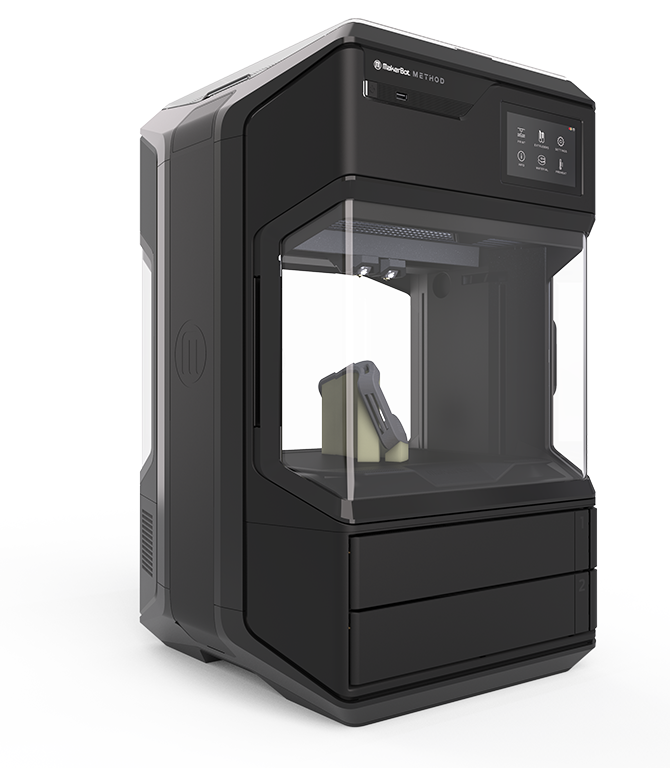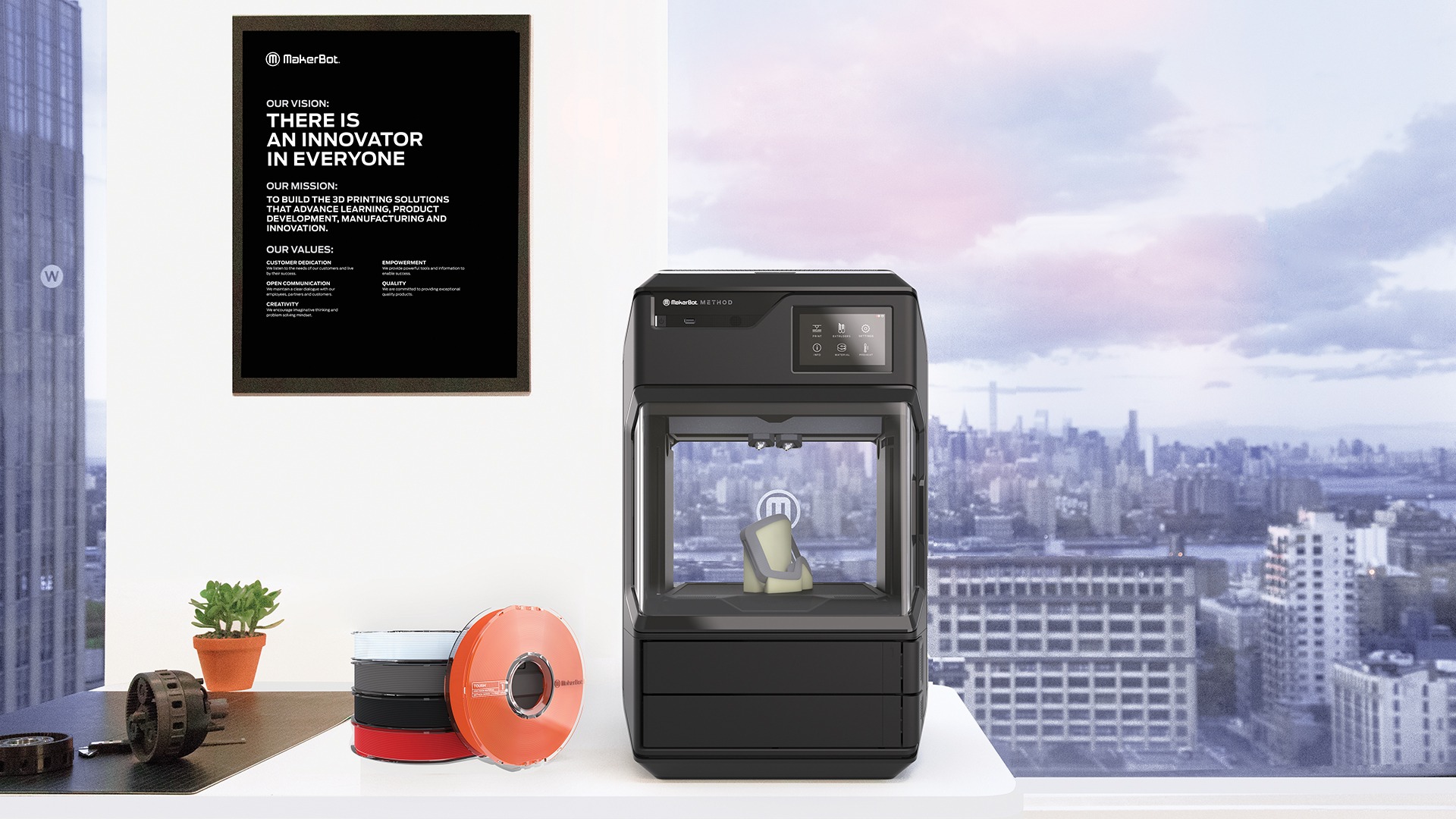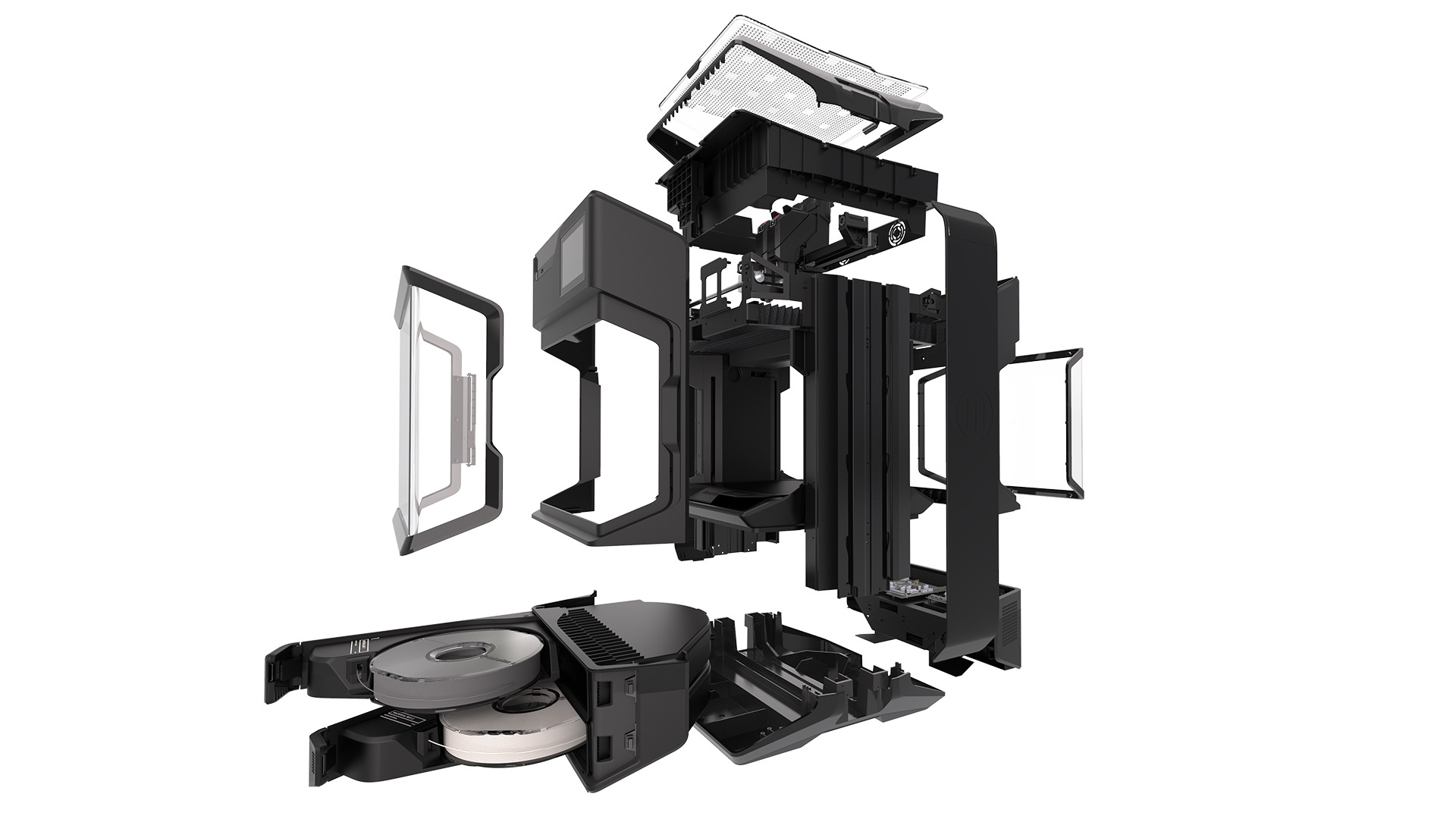BROOKLYN, NEW YORK – December 11, 2018 – MakerBot, the pioneer of desktop 3D printing, introduces a new category for the professional segment with the launch of Method, the first performance 3D printer. Performance 3D Printing bridges the gap between desktop and industrial 3D printing by bringing features that were previously only available on industrial 3D printers to professionals at a significantly lower cost. Method leverages industrial technologies and expertise from Stratasys® (NASDAQ: SSYS) and combines it with the accessibility and ease of use for which MakerBot is known.
Industrial technologies on the MakerBot Method 3D printer include a Circulating Heated Chamber, Dual Performance Extruders, Precision PVA Water Soluble Supports, Dry-Sealed Material Bays, and an Ultra-Rigid Metal Frame. Method also includes built-in sensors and automation features that are designed to provide users with a seamless experience. The printer’s industrial features control the 3D printing process to deliver a high level of precision, reliability, and dimensional accuracy at an accessible price. This technological breakthrough defines the new Performance 3D Printing category.
“In an age of disruption, businesses are under pressure to innovate and bring products to market faster. Current desktop 3D printers derive their DNA from hobbyist 3D printers and are insufficient for many applications in the professional segment,” said Nadav Goshen, MakerBot CEO. “We believe that Method is the next step in helping organizations adopt 3D printing at a larger scale. Method provides a breakthrough in 3D printing that enables industrial designers and mechanical engineers to innovate faster and become more agile. It is built for professionals who need immediate access to a 3D printer that can deliver industrial performance to accelerate their design cycles. Method is developed to bring industrial technologies into an accessible platform, breaking the price-performance barrier and redefining rapid prototyping in the process.”
Method is designed to deliver industrial reliability and precision by carefully controlling every aspect of the 3D print environment, resulting in repeatable and consistent parts with ± 0.2 mm dimensional accuracy1 as well as vertical layer uniformity, and cylindricity. Until now, this level of precision has been limited to industrial-grade 3D printers. The dual extrusion system found in Method combined with water-soluble PVA provides a superior surface finish, and enables unlimited design freedom and unrestricted geometries, such as complex overhangs without scarring.
Method allows users to turn their CAD files to parts faster by providing a seamless and reliable workflow without tinkering, up to 2X faster print speeds than desktop 3D printers2. Method offers out-of-the-box deployment and a hassle-free guided setup, making it easy to install and use. Method also includes automated maintenance procedures and support to ensure a smooth and seamless user experience.
Method delivers industrial-level performance at one-third of the first-year cost of ownership of an entry-level industrial 3D printer. With Method, teams can reduce design risks by testing and validating prototypes with accuracy early and often, minimizing potential cost overruns later in production. It is also designed to provide an elevated level of speed and control into product design cycles while reducing production costs – helping businesses bring products to market faster.
Industrial Reliability and Precision
From concept validation to functional part performance, Method is created to deliver consistent print results that match design dimensions.
- - The Circulating Heated Chamber controls the temperature and quality of every layer. In providing full active heat immersion during the entire duration of the print, Method allows printed materials to cool at a controlled rate, providing higher dimensional accuracy while improving layer adhesion and part strength
- - Dual Performance Extruders are built for high-speed printing without compromising part accuracy. A dual-drive gear system grips the material securely while a powerful 19:1 gear ratio provides up to 3X the push force of a typical desktop 3D printer. This allows Method to provide a consistent feed of material into the hot end to produce consistent geometry. The new lengthened thermal core is up to 50% longer than a standard desktop hot end to enable faster extrusion rates and, allowing for smooth extrusion throughout its high-speed movements and accelerations.
- - Precision PVA Dissolvable Supports enable fast and easy support removal without compromising part design or dimensional accuracy. Water-soluble PVA provides unrestricted geometric freedom and superior print quality and surface finish without the need for harsh solvents of industrial 3D printers or manual labor of removing breakaway supports.
- - Dry-Sealed Material Bays form a seal to keep filament material pristine and reduce moisture absorption. A suite of built-in sensors monitors humidity and alerts users of any changes to the environment—a feature previously only available in industrial 3D printers. This feature is especially crucial for water-soluble PVA, which quickly absorbs moisture when left in the open with devastating consequences on print quality.
- - MakerBot Materials for Method are manufactured to exacting diameter and quality specifications. Shipped in a vacuum-sealed metalized polyester bag, quality can be preserved right up until opening. MakerBot offers two categories of materials for use with Method: Precision and Specialty. Precision Materials are extensively tested by MakerBot for the highest reliability and measurably accurate parts and include MakerBot Tough, MakerBot PLA, and MakerBot PVA. Specialty Materials are for users looking for materials with advanced properties to push the limits of what's possible. These materials provide basic print performance and can require additional workflow steps to print successfully. The first material on the platform is PETG, one of the most widely used polymers with excellent engineering properties, with more to follow.
- - The Ultra-Rigid Metal Frame runs the full length of the Method body to offset flexing. Less flexing means more consistent prints with better part accuracy and fewer failures.
Faster, Better 3D Printing
Method makes industrial 3D printing technologies accessible to individual designers and engineers. Advanced workflow features turn Method into an everyday tool that accelerates the agile design process. Users can turn their CAD files to parts faster and print up to 2X faster than desktop 3D printers.
- - The Smart Spool provides valuable information, including type, color, and amount of material remaining via an RFID chip directly to MakerBot Print, while desiccant in the spool maintains a low moisture level inside the drawer bay.
- - The 5” Capacitive Touchscreen provides the latest status updates of current print jobs and allows users to navigate the menus in the most intuitive way.
- - MakerBot Print Software easily integrates with 25 of the most popular CAD programs to allow designers and engineers to design with what they know best. For easy collaboration, teams can also save 3D files as projects and share them via the native Cloud Management platform. Method’s built-in onboard camera also allows users to monitor their print progress remotely with MakerBot Print or the MakerBot Mobile app.
- - The Spring Steel Build Plate provides true flatness for unyielding part accuracy and enables the printed part to pop off the plate.
The MakerBot Method 3D printer has been tested by MakerBot for over 220,0003 hours of system reliability, subsystem, and print quality testing.
The MakerBot Method 3D Printer has a starting price of $6,499. Shipping of Method is expected to begin in Q1 2019. Pre-orders are now available. To learn more about the MakerBot Method 3D printer, visit makerbot.com/Method.
MakerBot also has dedicated business offerings that are created to reduce downtime and keep teams moving. To learn more about Method for Business, visit makerbot.com/Method-for-Business.

























